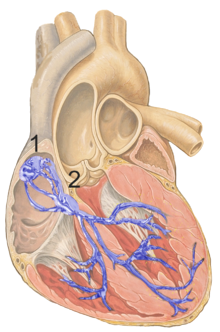Atrioventricular (AV) node
Материал из CardioWiki
Версия от 11:21, 25 марта 2017; Wikiadmin (обсуждение | вклад)
Atrioventricular (AV) node (the node Aschoff-Tawara) is located in the right rear-bottom part of the interatrial septum.
Its dimensions are 0.5-0.6 cm in length, 0.2-0.3 cm in width and not more than 0.1 cm in thickness. In most cases, it gets the blood supply from branch of the right coronary artery. The AV node has an extremely low speed of impulse conducting, on average, 0.05 m / s, which determines its basic functions.
These functions are:
- physiological delay of transmission of excitation from the atria to the ventricles, which ensures synchronization of their activities (atrial contraction precedes the ventricular contractions);
- protection of ventricles from possible too frequent impulses from the atria; the AV node is a kind of "barrier", "filter" on the way between the atria and ventricles;
- protection of ventricles from possible too early atrial impulses, which might catch the ventricles in a vulnerable phase;
- protection of ventricles from possible long-term asystole; when an atrial impulse is too late, AV node becomes the generator of the ventricular rhythm.
The AV node has a complex morphological and electrophysiological structure and combining with paranodal tissues and initial part of the bundle of His forms the so-called atrioventricular connection. The innervation of the AV node is provided by sympathetic and parasympathetic nerves.


